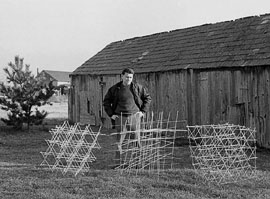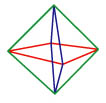Woven Space-Frames
Weaving in its familiar planar patterns has existed since the beginning of civilization. No artifact survives to tell where or when it was that humans discovered this magnificent art; that by using strips of hide or reeds and passing them rhythmically over and under one another, it was possible to produce material useful for all sorts of things. To invent weaving must have been indeed astonishing.
Whether or not my discovery that weaving can be done not only in two dimensions but in three-dimensional space is new or merely the uncovering of someone else's ancient idea, I do not know.
I discovered 3D weaving in 1965. Here is a photo from that time with the octahedral and tetrahedral systems, plus a third type which is essentially cubical. The cube form lacks triangulation and results in an unstable spaceframe.

A websearch turns up "3D Weaving" but it refers not to genuine weaving, but simply to the orderly laying of threads in three directions without actually interlacing them over-and-under one another.
If it is a re-invention, I happened across it by making modularly repeated tensegrity systems and seeing that the patterns of weaving were clearly there.
I found that, like flat weaving, there are two possible modes of space-weaving and those relate to the octahedron and tetrahedron in the same way that flat weaves relate to woven squares or to woven triangles and hexagons.
Volumetric weaving is in fact an extension of conventional weaving. The two-way and three-way flat planes criss-cross in orderly ways that define the arrays of three dimensional weave-polyhedra. The triangle polygons of the flat weave become the triangle faces of octahedra and tetrahedra. The two-way weave's squares become the three bisecting

A likely reason it hasn't been observed or practiced is that, while there are endless uses for fabric and basket weaving, there has been no necessity for space-frame weaving, especially since accomplishing woven space-frames is a tedious business -- and that there exist a dozen ways to build space-frames without weaving them. To discover that it exists, is value enough. Sometimes the mother of invention has nothing to do with necessity, but only with curiosity. The following pages illustrate the two forms of three-dimensional weaving.